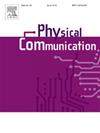Energy-efficient joint power control and channel allocation for D2D communication underlaying cellular network
IF 2
4区 计算机科学
Q3 ENGINEERING, ELECTRICAL & ELECTRONIC
引用次数: 0
Abstract
The Device-to-device (D2D) communication technology can significantly improve the efficiency of wireless spectrum resources and expand the communication system’s capacity. In order to enhance the energy efficiency (EE) of D2D communication, a two-stage cross-layer optimization approach in which joint power control and channel allocation is proposed. In this work, the optimization objective is to maximize the total EE of D2D users (DUEs) to enable green D2D communications in cellular networks. The proposed resource allocation problems are NP-hard, which is typically difficult to solve directly. We decouple the EE optimization problem of joint power control and channel allocation into two sub-problems: Power Control and Channel Allocation. First, the Improved Grey Wolf Optimization (IGWO) algorithm is proposed to obtain the optimal transmission power of DUEs and Cellular users (CUEs) in the first phase. Then, the Hungarian Algorithm (HA) is utilized to accomplish optimal channel match for DUEs and CUEs in the second phase. Compared to other alternative algorithms, the simulation results show that the suggested scheme effectively improves the system’s EE.
为覆盖蜂窝网络的 D2D 通信提供高能效联合功率控制和信道分配
设备到设备(D2D)通信技术能显著提高无线频谱资源的效率,扩大通信系统的容量。为了提高 D2D 通信的能效(EE),提出了一种联合功率控制和信道分配的两阶段跨层优化方法。在这项工作中,优化目标是最大化 D2D 用户(DUEs)的总能效,以实现蜂窝网络中的绿色 D2D 通信。所提出的资源分配问题是 NP 难问题,通常很难直接解决。我们将联合功率控制和信道分配的 EE 优化问题解耦为两个子问题:功率控制和信道分配。首先,我们提出了改进灰狼优化(IGWO)算法,以在第一阶段获得 DUE 和蜂窝用户(CUE)的最佳传输功率。然后,在第二阶段利用匈牙利算法(HA)实现 DUE 和 CUE 的最佳信道匹配。与其他替代算法相比,仿真结果表明所建议的方案能有效改善系统的 EE。
本文章由计算机程序翻译,如有差异,请以英文原文为准。
求助全文
约1分钟内获得全文
求助全文
来源期刊

Physical Communication
ENGINEERING, ELECTRICAL & ELECTRONICTELECO-TELECOMMUNICATIONS
CiteScore
5.00
自引率
9.10%
发文量
212
审稿时长
55 days
期刊介绍:
PHYCOM: Physical Communication is an international and archival journal providing complete coverage of all topics of interest to those involved in all aspects of physical layer communications. Theoretical research contributions presenting new techniques, concepts or analyses, applied contributions reporting on experiences and experiments, and tutorials are published.
Topics of interest include but are not limited to:
Physical layer issues of Wireless Local Area Networks, WiMAX, Wireless Mesh Networks, Sensor and Ad Hoc Networks, PCS Systems; Radio access protocols and algorithms for the physical layer; Spread Spectrum Communications; Channel Modeling; Detection and Estimation; Modulation and Coding; Multiplexing and Carrier Techniques; Broadband Wireless Communications; Wireless Personal Communications; Multi-user Detection; Signal Separation and Interference rejection: Multimedia Communications over Wireless; DSP Applications to Wireless Systems; Experimental and Prototype Results; Multiple Access Techniques; Space-time Processing; Synchronization Techniques; Error Control Techniques; Cryptography; Software Radios; Tracking; Resource Allocation and Inference Management; Multi-rate and Multi-carrier Communications; Cross layer Design and Optimization; Propagation and Channel Characterization; OFDM Systems; MIMO Systems; Ultra-Wideband Communications; Cognitive Radio System Architectures; Platforms and Hardware Implementations for the Support of Cognitive, Radio Systems; Cognitive Radio Resource Management and Dynamic Spectrum Sharing.
 求助内容:
求助内容: 应助结果提醒方式:
应助结果提醒方式:


